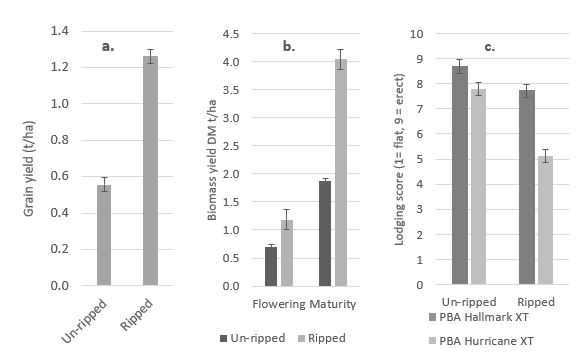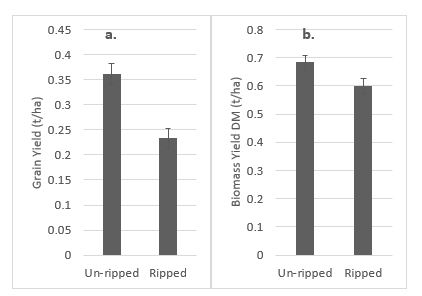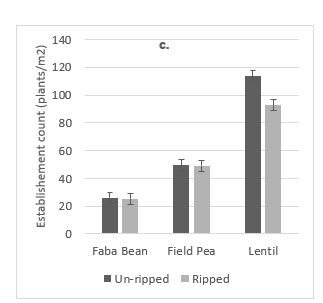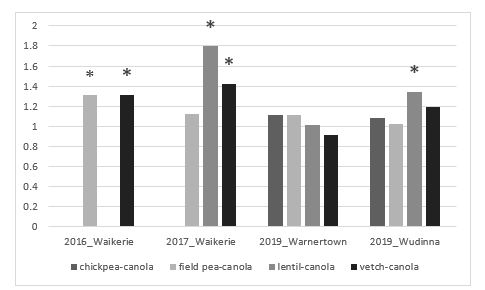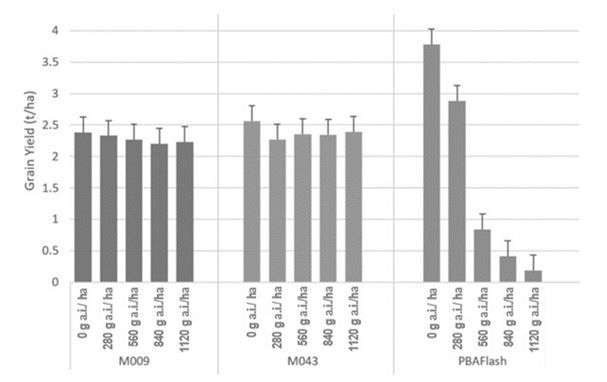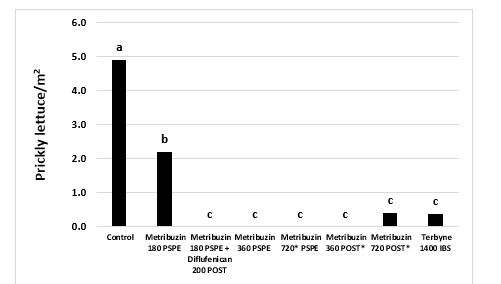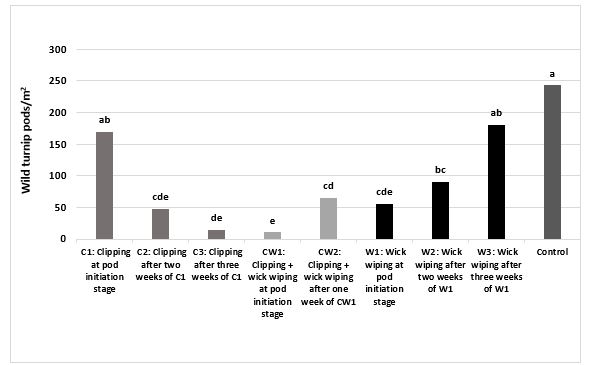Spotlight on pulses
Take home messages
- Group B tolerance traits are now commercially available in lentil and faba bean.
- There are several emerging technology and genetic traits being developed, including target site tolerance traits to different modes of action (Group C and Group I).
- Integrated weed management strategies are critical to sustainable farming systems and several alternative methods are being explored including wick wiping and clipping.
- Deep ripping in the right situation can overcome subsoil constraints and result in improved lentil yield in the first year of ripping.
- Pulse-oilseed intercropping has the potential to increase productivity in the low rainfall environment.
Background – the pulse journey in South Australia (SA)
The adoption of pulse crops in SA has increased over the past 20 years, with pulses making up an important part of the farming system in all rainfall zones of SA. The total area planted to pulses has increased from 300 000 ha in the early 2000s to over 400 000 ha by 2019, with a corresponding increase in total pulse grain production (ABARES, 2019). There have also been shifts in the areas planted to specific pulse crop types over this timeframe. Since the mid-2000s the area planted to field pea and lupin has steadily declined (ABARES, 2019). In contrast, we have seen a rapid increase in the areas of lentil planted, which is now the predominant pulse grown in SA. Strong commodity prices for lentil and faba bean have influenced the expansion in area planted to both crops since 2014/2015. While the release of herbicide tolerance cultivars such as PBA Hurricane XT in 2014, has seen expansion of lentil into new areas. With significant improvements in disease management strategies for faba bean, and the recent release of an herbicide tolerant faba bean, we expect to see planting areas increase. In the meantime, chickpea production area has seen a consistent and steady increase despite the increased challenge of managing ascochyta blight (AB).
Recent reviews into pulse production trends into the future indicate ‘the commodity supply and demand scenario for pulse crops to 2030 looks healthy, albeit with some volatility’ (Pulse Australia, 2019). This outlook is driven by the expectation of existing and expanding markets through the sub-continent, China and Africa, as well as the evolving demand for plant-based protein in the food sector (Pulse Australia, 2019). One of the big future challenges for the pulse industry is to achieve greater yield stability in pulse crops across a range of environments. Experience has shown that this will come from the combination of genetic and agronomic solutions.
This paper describes and highlights some of the current and future research directions that will enable continued growth of the SA pulse industry. The research highlights the focus on efforts to improve pulse production on constrained soils, novel agronomic opportunities to increase productivity in the low rainfall zones through mixed species cropping, future genetic solutions in the development of herbicide tolerance traits, and alternative strategies for weed control in pulses.
Results and discussion
Agronomy – priority constraints to pulse production
With the rapid expansion and intensification of pulse crop production over the last two decades, there are a range of new constraints to production. In addition, the potential for each specific crop within the different growing regions is not well understood. Emerging research into soil constraints, as well as alternative production strategies such as intercropping, could provide growers with different strategies to maximise pulse potential, particularly in marginal growing areas.
Constrained soils
The aim of this research is to understand the impact of a range of management and agronomic treatments on soil types identified as constrained by local farmers or agronomists, within key pulse growing regions.
One management strategy in focus is the use of mechanical ripping prior to seeding a pulse crop in year one, with the aim of improving root growth and yields of pulses on sandy loam to loam soils. Trial sites were established at Bute (lentil) and Kimba (faba bean, field pea, and lentil) in 2019. Soil sample were taken pre-seeding 2019. The soil type at Bute is sand to sandy loam with pH (CaCl2) of 6.9 in 0-10 cm layer and 5.8 in 10-30 cm. The soil type at Kimba is loam with a pH (CaCl2) of 7.7 in 0-10cm layer and 7.9 in 10-30 cm layer.
Ripping improved the agronomic performance of lentil at Bute, with grain yields 126% higher in the ripped versus un-ripped plots (Figure 1a and 1b). Similarly, biomass was 70% and 116% higher at flowering and maturity respectively in the ripped versus un-ripped plots. In addition, the ripped plots achieved canopy closure while the un-ripped plots did not. The only negative response to ripping at this site was an increase in lodging for both PBA Hallmark and PBA Hurricane, as a result of increased biomass production (Figure 1c).
In contrast, there was a negative grain yield and biomass response to the ripping treatment at Kimba for lentil, faba bean and field pea (Figure 2a and 2b). Establishment in lentil was reduced in the ripped treatment, whilst faba bean and field pea were unaffected (Figure 2c). Biomass was reduced in the ripped treatments, as was grain yield. It is important to note; grain yields ranged between 170 kg/ha to 430 kg/ha due to rainfall less than half of the long-term average. The negative response to ripping at Kimba is likely to be the result of the soil texture being heavier than that of a sand to sandy loam — the response to ripping is expected to be greater in sandy soils and reduces as texture increases (Sadras et al., 2005). Poor seasonal conditions may have also impacted results. Conditions at Kimba were drier than ideal at the time of ripping (January to April rainfall total of 10.4mm), followed by below average growing season rainfall (129mm).
This contrasting first year response between Bute and Kimba highlights the opportunity for improved pulse production on compacted soils, keeping in mind the importance of understanding the individual-site soil characteristics and seasonal outlook prior to imposing any mechanical management techniques to reduce compaction.
Figure 1. Lentil grain (a.) and biomass (b.) yielded higher in the ripped versus un-ripped treatment, whilst lodging score (c.) was lower at Bute, 2019. Bars represent least significant difference (LSD) at p=0.05.
Figure 2. Grain yield (a.) and biomass yield (b.) response to ripping treatment. Lentil emergence counts (c.) were lower in ripped treatment versus un-ripped treatment; faba bean and field pea were unaffected by ripping treatment at Kimba, 2019. Bars represent least significant difference (LSD) at p=0.05.
Novel agronomy – intercropping in the low rainfall zone
The aim of the research was to demonstrate that intercropping has the potential to increase both productivity and financial return in low rainfall cropping regions. In addition, the adoption of this practice could lead to ancillary benefits, such as increasing groundcover on erosion-prone soils. Sites were established at Warnertown and Wudinna in 2019 based on previous work undertaken at Waikerie in 2016 and 2017 (Roberts et al., 2019), data included. Treatments included the intercrop combination of chickpea-canola, field pea-canola, lentil-canola, vetch-canola and monoculture treatments of each crop type.
To determine the relative benefit of intercropping, compared to growing crops as monocultures, land equivalent ratio (LER) values were calculated. The LER is expressed as:
LER = LA + LB = YA/SA + YB/SB
LA and LB are the LER for the individual crop yield components, where YA and YB are the individual crop yields in the intercrop combinations, and SA and SB are the yields of the monocultures (adapted from Mead and Willey, 1980). An LER value of 1.0 means the productivity of the intercrop components was equivalent to the monocultures. An LER value of <1.0 means the productivity of the intercrop components are lower than the monocultures, while an LER value >1.0 means the intercrop components are more productive than the monocultures, which is referred to as ‘over-yielding’. Confidence limits (CL) were used to determine over-yielding effects for LER values. We concluded that over-yielding occurred when the 95% lower CL was >1.
The results from Waikerie, Warnertown and Wudinna support the hypothesis that intercropping pulses and oilseeds in the low rainfall zones of SA has the potential to increase productivity (Figure 3). Over-yielding, as measured by LER, occurred in both years at Waikerie for the intercropping combination of vetch-canola. Additionally, lentil-canola intercrops over-yielded at Waikerie and Wudinna. Further crop combinations warrant exploring in low rainfall environments, as do the potential ancillary benefits, such as increasing groundcover on erosion-prone soils, nitrogen fixation, and fodder production as a secondary end use benefit.
Figure 3. Intercropping demonstrates grain yield benefits for some intercrop combinations with land equivalent ratio (LER) values of greater than one, treatments marked with * were determined over-yielding (95% confidence limit greater >1).
Weed management and novel traits
A major constraint to pulse production is weed management. The recent Group B herbicide tolerance traits in lentil and faba bean have been extremely popular, and the uptake of this technology across crops is creating a shift in herbicide usage patterns across the whole cropping system. Various strategies are being explored to address both current and emerging issues from this continuously changing dynamic, including the development of herbicide tolerance traits across multiple modes of action, and alternative weed management strategies such as wick wiping and clipping.
Emerging technology and potential for new traits
Modern day farming practices have increased the reliance on herbicides for weed control. However, with limited safe or suitable control options currently registered in pulse crops and few, if any, new herbicides being introduced to the market, there is an increasing need to maximize the use of available products.
GRDC-supported research at SARDI has been focusing on developing herbicide tolerance traits across multiple modes of action to provide robust, broad-spectrum weed control as well as to ensure the longevity of these technologies and sustainable weed control options into the future. This work has resulted in the delivery of Group B tolerance traits in faba bean, with work underway in chickpea and field pea.
In addition, high levels of target site tolerance have been developed across multiple herbicide groups including Group C in lentil and Group I in lentil, field pea, faba bean and chickpea (Figure 4 and 5). These herbicide groups, and their usage in mixtures, could provide growers with control options for a range of key problematic weeds in pulse production.
Figure 4. Across site analysis of lentil grain yield from Melton and Pinery 2016 trials comparing two Group C tolerant lines (M009 and M043) with commercial variety PBA Flash at five rates of metribuzin herbicide applied at the five-node growth stage. Error bars represent least significant difference (LSD) at p=0.05. (Data from L McMurray PhD).
Figure 5. Grain yield response of Group I tolerant chickpea selections CL038 and CL041 compared to PBA HatTrick at four rates of clopyralid applied at the five-node growth stage, Riverton, SA, 2018. Bars represent least significant difference (LSD) at p=0.05.
With the successful development of tolerance traits to multiple herbicide groups in each crop, one of the on-going aims of the SARDI research is to evaluate and maximise the potential of these traits, together with their integration into pulse breeding programs. The research will also focus on maximising the benefit of this technology for each crop, including their potential for use in mixtures and the development of dual tolerant lines. Given the novelty of these traits, particularly the group C and I traits — never reported in any other crop, further work including exploring the genetic control and adaptation of these traits is required to commercialise this technology.
GRDC supported research has also been underway to evaluate the current and future implications of changing herbicide usage patterns on weed management. The research aims to evaluate the potential for best management practices with these new and emerging herbicide tolerant technologies. Research findings on the Group C tolerant lentil germplasm line (M043) has shown potential to control prickly lettuce (Figure 6) and Group B resistant common sowthistle (Figure 7). Group C herbicides were applied as incorporation by sowing, IBS (Terbyne®750 WG at 1400 g/ha), post-sowing pre-emergence (PSPE) and post-emergence (POST) applications of Metribuzin 750 WG at 360-720 g/ha (at five-node crop stage). Once available, the Group C tolerance traits have the potential to diversify selection pressure from Group B herbicides used in PBA Hurricane XT lentil. This would be achieved by offering alternative herbicide options, particularly for controlling Group B-tolerant broadleaf weeds in pulse crops. A post emergent application of Diflufenican 500 SC at 200 mL/ha caused some bleaching in lentil leaves but the crop recovered two to three weeks post application.
Figure 6. Prickly lettuce populations in Group C lentil germplasm (M043). Bars labelled with the same letter are not significantly different (P≤0.05). *Herbicide usage pattern/dose for experimental purpose only.
Figure 7. Common sowthistle populations in Group C lentil germplasm (M043). Bars labelled with the same letter are not significantly different (P≤0.05). *Herbicide usage pattern/dose for experimental purpose only.
Integrated Weed Management (IWM) – alternative strategies for weed control in pulses
With the increasing frequency of pulse crops in rotation, broadleaf weed control has become challenging due to limited safe herbicide options. While there is an increasing availability of herbicide tolerance traits in all crop species, alternative strategies are crucial to maintaining sustainable weed control options. Alternative methods have significant importance for pulse crops due to broadleaf weeds, such as wild turnip, common sowthistle and Indian hedge mustard, now reported to have developed resistance against imidazolinone herbicides (Boutsalis et al., 2016, and Aggarwal et al., 2019). The development of new IWM strategies will allow greater in-crop broadleaf control and reduce in-crop weed seed set and build-up of the soil weed seed bank in pulse-based rotations.
The potential benefits from wick wiping and clipping for reducing the seed set of wild turnip in lentil were studied in a research trial established at Turretfield Research Centre in 2019. The trial tested the response of wild turnip to wick wiping with Glyphosate + LVE MCPA + water mixed as 1:1:1 and the application of weed clipping just above the lentil canopy at different growth stages. The wick wiping and clipping treatments were applied at weekly intervals, starting from wild turnip pod initiation stage. A gravity-based wick wiper was used, and clipping was done manually. Observations on wild turnip pod set were recorded just before harvest of the lentil crop.
The timing of clipping treatments was an important factor in reducing pod set of wild turnip, with later clipping treatments (at two and three weeks after wild turnip pod initiation) reducing pod set compared to the earlier treatment (at pod initiation). However, the opposite effect was observed with wick wiping. Earlier wick wiping treatments (up to two weeks after pod initiation) resulted in reduced weed pod set, compared to late wick wiping (three weeks after pod initiation). Both earlier treatments of wick wiping, and later treatments of clipping resulted in lower weed pod set compared to the control. When combining the two treatments of clipping and wick wiping, earlier timing (at pod initiation) reduced weed pod set compared to the later timing (one week after pod initiation). Both combined treatments resulted in reduced weed pod set compared to the control but were not significantly different to the treatments of delayed clipping, or straight wick wiping at pod initiation.
Figure 8. Wild turnip pod set as affected by wick wiping and clipping in lentil. Bars labelled with the same letter are not significantly different (P≤0.05).
Conclusion
This paper demonstrates the growth of pulse production in SA over the last 20 years, and the opportunity to achieve greater yield stability in pulse crops across a range of environments. Results from pulse agronomy and pre-breeding research demonstrates the continued combination of both genetic and agronomic solutions will allow us to achieve future gains to pulse production in both established and developing production regions.
Acknowledgements
The research undertaken as part of this project is made possible by the significant contributions of growers through both trial cooperation and the support of the GRDC, the author would like to thank them for their continued support.
Useful resources
2019 South Australian Crop Sowing Guide - GRDC
National Variety Trails (NVT Online) - GRDC
Deep Ripping Fact Sheet pdf - GRDC
References
ABARES (2019) ‘Australian Crop Report February 2019.’ (Australian Bureau of Agricultural and Resource Economics and Sciences, Canberra)
Aggarwal, N., Gontar, B., Pearce, A., Dzoma, B., Arsego, F., Roberts, P., Oakey, H., Li, W., Boutsalis, P. and McMurray, L. (2019) Weed responses to high break crop intensity systems. In ‘Adelaide GRDC Updates proceedings.’ pp. 12-13 and 41-46.
Boutsalis, P., Gill, G. and Preston, C. (2016) ‘Risk of addiction to IMIs (Group B imidazolinone herbicides)’. GRDC update papers.
McDonald, G.K., Hollaway, K.L. and McMurray, L. (2007) Increasing plant density improves weed competition in lentil (Lens culinaris). Australian Journal of Experimental Agriculture 47, 48-56.
Mead R. and Willey, R.W. (1980) The concept of a ‘land equivalent ratio’ and advantages in yields from intercropping. Methodology of Experimental Agriculture, 16, 217-228.
Pulse Australia (2019) Raising the Pulse, The view to 2030 for Australian Pulses – Opportunities and Challenges. (Pulse Australia)
Roberts, P., Moodie, M. and Wilhelm, N. (2019) Intercropping increases productivity in the South Australian Mallee. In ‘19th Australian Agronomy Conference.’ (Toowoomba)
Sadras, V., O’Leary, G.J. and Roget, D.K. (2005) Crop response to compacted soil: capture and efficiency in the use of water and radiation. Field Crop Research 91, 131-148.
Contact details
Penny Roberts
70 Farrell Flat Rd (postal: 155 Main North Rd), Clare SA 5453
0436 678 982
penny.roberts@sa.gov.au
@PennyRo25927708
GRDC Project Code: DAV1706-003RMX, DAS00168BA, 9176607,
Was this page helpful?
YOUR FEEDBACK

